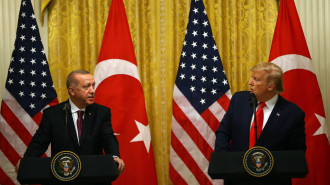
Israel's struggle to defeat Hamas: An impossible war?

On 21 November, the US, Qatar, and Egypt achieved the first major diplomatic breakthrough of the 2023 Gaza war.
They brokered an agreement which will secure the release of 50 Israeli hostages and 150 Palestinian prisoners and facilitate a four-day truce between Israel and Hamas.
The agreement also allowed hundreds of trucks of food, medicine, and fuel supplies to reach the besieged Gaza Strip.
This agreement, while promising, is very unlikely to lead to a lasting peace. As the Israeli cabinet ratified the agreement, Netanyahu declared “We are at war, and we will continue the war. We will continue until we achieve all of our goals”.
"Netanyahu faces a long struggle to completely vanquish Hamas and save his tarnished political legacy"
Netanyahu’s far-right coalition partners were even more emphatic in Israel’s need to continue the war. Israeli National Security Minister and Otzma Yehudit (Jewish Power) leader Itamar Ben-Gvir warned that the hostage release deal would be a “disaster” and compared it unfavourably to Israeli soldier Gilat Shalit’s release.
Shalit was freed from Hamas’ custody in 2011 in exchange for 1,027 Palestinian prisoners, including Hamas leader in Gaza Yahya Sinwar.
But does Israel have a path to victory on Netanyahu’s terms? Six weeks into the Gaza war, which has resulted in the deaths of at least 14,500 Palestinians, Netanyahu faces a long struggle to completely vanquish Hamas and save his tarnished political legacy.
Even if Israel manages to assassinate the al-Qassam Brigade’s leading commanders, a swift transition to Palestinian self-rule is remote and a costly Israeli occupation of Gaza looms.
Israel's tough road to military victory over Hamas
After Israel’s ground operations intensified on 27 October, the Israeli army aimed to encircle Hamas’ strongholds by bifurcating the Gaza Strip. Israel’s military invaded the enclave through Beit Hanoun in northern Gaza and Bureij in central Gaza, which is a path that it has used during previous offensives against Hamas and Islamic Jihad.
The Israeli military strategy has obtained some early successes. It achieved a swift encirclement of Gaza City, which was ensconced by the bifurcation of the Gaza Strip.
On 6 November, Israeli army spokesperson Rear Admiral Daniel Hagari declared that “today there is north Gaza and south Gaza”. By 21 November, the army had encircled Jabaliya in northern Gaza, which Israel has described as a key Hamas stronghold.
Despite these victories, the Israeli military’s most difficult tasks lie ahead. When hostilities in the Gaza Strip resume after a short-term ceasefire, the Israeli army will be forced to engage in urban warfare.
|
|
This does not play to its strengths. The Israeli military excels when it can leverage the agility of its forces to deliver concentrated strikes in unexpected places. This advantage was the cornerstone of Israel’s victories against much larger Arab forces in the 1967 Six-Day War and 1973 Yom Kippur War.
In the Gaza war, Hamas has the advantage of surprise as its forces can emerge from their tunnels to strike Israel’s army from its rear flanks and then disappear. This tactic resembles the modus operandi that Hamas used to strike Israel on 7 October.
Ahead of those attacks, Hamas fighters emerged from multiple tunnel exits in the security fence around Gaza and poured into southern Israel.
While the Israeli army can map out Hamas’ tunnel networks with LANIUS drone-based loitering munitions, these surveillance technologies can still miss Hamas’ last-minute tunnel exit constructions. Due to unexpected booby traps and oxygen depletion risks, Israel will only send its forces to fight Hamas in the tunnels in extreme circumstances.
"Netanyahu is likely to defy international pressure for a ceasefire in the short term but faces an epic struggle to vanquish Hamas, safeguard Israel's remaining hostages, and provide a roadmap for long-term stability in Gaza"
The 2014 Operation Protective Edge campaign provides a cautionary tale of what Israel could experience. Ahead of that war, the Israeli army focused on Air Force development and intelligence gathering and assumed that shock-and-awe aerial bombardments would deal a devastating blow to Hamas and deter the militant group from future strikes.
The Israeli army’s assumption unravelled during the first week of the war, as Hamas held firm against an Israeli Air Force (IAF) onslaught. Israel was forced to deploy ground forces with the intention of destroying Hamas’ tunnel network, but it failed to achieve this goal and eventually accepted an open-ended ceasefire.
Israel’s army has redressed some of these issues, as it has invested heavily in armoured vehicles and gained more experience dismantling Hamas’ tunnel infrastructure. However the structural difficulties of urban combat in Gaza point to a long war.
Netanyahu’s comments describing the Gaza war as a “second war of independence” for Israel and refusal to rule out a war of longer than a year against Hamas underscore these harsh realities.
Netanyahu's legacy and Gaza's future hang in the balance
The 7 October attacks shattered Netanyahu’s cultivated image as an effective custodian of Israel’s security. A 20 October Maariv poll revealed that 80% of Israelis and 69% of Likud Party supporters believe that Netanyahu must take personal responsibility for Hamas’ attacks.
Opinion polls also show that Netanyahu faces an uphill struggle to win re-election once the Gaza war is over. A 15-16 November Maariv poll gave Benny Gantz’s National Unity alliance 42% support compared to 17% for Netanyahu’s Likud Party.
Beyond this collapse in popularity, the Gaza war has dealt serious blows to Netanyahu’s foreign policy legacy. Saudi Crown Prince Mohammed bin Salman’s declaration that the international community should cease arms sales to Israel underscores the dwindling prospects of an Israel-Saudi Arabia normalisation agreement.
Jordan’s military mobilisation on Israel’s borders suggests that even age-old diplomatic breakthroughs are in jeopardy. Moreover, Netanyahu’s decade-long charm offensive towards Russia and China has unravelled as both countries assume firmly pro-Palestinian stances.
|
|
Due to these negative headwinds and strains in Israel’s economy, Netanyahu could face pressure to resign before the Gaza war is over. On 16 November, Israel’s Leader of the Opposition Yair Lapid called for a no-confidence vote against Netanyahu and declared “Netanyahu should leave immediately. We need change. Netanyahu cannot remain Prime Minister.”
Lapid is very unlikely to achieve this objective, as Likud is unwilling to consider a leadership change in a time of war, but it reflects Netanyahu’s dire political outlook.
The near-term political future of the Gaza Strip looks equally grim. Although Israeli officials have repeatedly ruled out a West Bank-style occupation of Gaza, Netanyahu believes that Israel should maintain “indefinite security responsibility” for the enclave after Hamas’s ouster. US President Joe Biden has pushed back against Netanyahu’s plans by warning that occupying Gaza would be a “big mistake” and calling for a two-state solution.
"The near-term political future of Gaza looks grim. Although Israeli officials have repeatedly ruled out a West Bank-style occupation, Netanyahu believes that Israel should maintain indefinite security responsibility"
If Netanyahu caves to US pressure and allows a swift return to Palestinian self-rule in the Gaza Strip, a truly representative Palestinian government could struggle to take root. To the frustration of US officials and their Arab counterparts, Netanyahu has already ruled out a Palestinian Authority (PA) takeover of the Gaza Strip.
Even if Netanyahu’s successor has a different view, the PA might not accept control over Gaza, as it fears that such overt collaboration with Israel would further erode its standing in the West Bank.
Mohamed Dahlan, Israel’s rumoured choice to lead the Gaza Strip after Hamas’s overthrow, is both highly unpopular and a wild card. PA President Mahmoud Abbas has accused Dahlan of involvement in the death of Yasser Arafat, which sullied his reputation amongst ordinary Palestinians.
Since his expulsion from Fatah in 2011, Dahlan has been a close confidante of UAE President Mohammed bin Zayed and played a role in facilitating the 2020 Israel-UAE normalisation agreement.
Since Netanyahu’s return as prime minister in 2022, Dahlan has called for a one-state solution to the Israel-Palestine conflict and the immediate post-war international recognition of a Palestinian state.
These are non-starters for Netanyahu or any Israeli leader who is likely to replace him. Even if Dahlan were to sideline these goals, the risk of Islamic Jihad assuming Hamas’s mantle and the formation of new hardline militant groups is high.
While Netanyahu remains firmly committed to its goal of eviscerating Hamas, his single-minded determination belies the real possibility that Israel is fighting an impossible war in Gaza.
Netanyahu is likely to defy international pressure for a ceasefire in the short term but faces an epic struggle to vanquish Hamas, safeguard Israel’s remaining hostages, and provide a roadmap for long-term stability in Gaza.
Samuel Ramani is a tutor of politics and international relations at the University of Oxford, where he received a doctorate in 2021. His research focuses on Russian foreign policy towards the Middle East
Follow him on Twitter: @SamRamani2








 Follow the Middle East's top stories in English at The New Arab on Google News
Follow the Middle East's top stories in English at The New Arab on Google News


